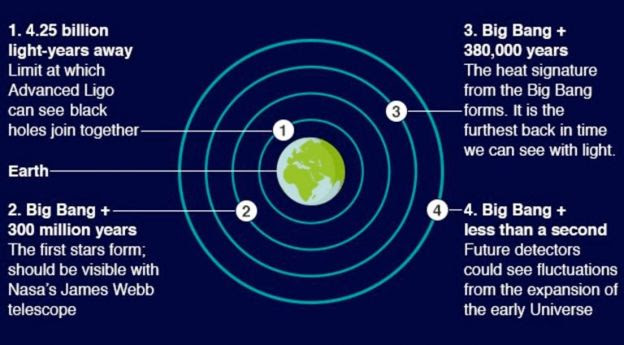Scientists are claiming a stunning discovery in their quest to fully understand gravity.
They have observed the warping of space-time generated by the collision of two black holes more than a billion light-years from Earth.
The international team says the first detection of these gravitational waves will usher in a new era for astronomy.
It is the culmination of decades of searching and could ultimately offer a window on the Big Bang.
The research, by the LIGO Collaboration, has been published today in the journalPhysical Review Letters.
The collaboration operates a number of labs around the world that fire lasers through long tunnels, trying to sense ripples in the fabric of space-time.
Expected signals are extremely subtle, and disturb the machines, known as interferometers, by just fractions of the width of an atom.
But the black hole merger was picked up by two widely separated LIGO facilities in the US.
The merger radiated three times the mass of the sun in pure gravitational energy.
"We have detected gravitational waves," Prof David Reitze, executive director of the LIGO project, told journalists at a news conference in Washington DC.
"It's the first time the Universe has spoken to us through gravitational waves. Up until now, we've been deaf."
Prof Karsten Danzmann, from the Max Planck Institute for Gravitational Physicsand Leibniz University in Hannover, Germany, is a European leader on the collaboration.
He said the detection was one of the most important developments in science since the discovery of the Higgs particle, and on a par with the determination of the structure of DNA.
"There is a Nobel Prize in it - there is no doubt," he told the BBC.
"It is the first ever direct detection of gravitational waves; it's the first ever direct detection of black holes and it is a confirmation of General Relativity because the property of these black holes agrees exactly with what Einstein predicted almost exactly 100 years ago."
- Gravitational waves are prediction of the Theory of General Relativity
- Their existence has been inferred by science but only now directly detected
- They are ripples in the fabric of space and time produced by violent events
- Accelerating masses will produce waves that propagate at the speed of light
- Detectable sources ought to include merging black holes and neutron stars
- LIGO fires lasers into long, L-shaped tunnels; the waves disturb the light
- Detecting the waves opens up the Universe to completely new investigations
That view was reinforced by Prof Stephen Hawking, who is an expert on black holes. Speaking exclusively to BBC News, he said he believed that the detection marked a key moment in scientific history.
"Gravitational waves provide a completely new way at looking at the Universe. The ability to detect them has the potential to revolutionise astronomy. This discovery is the first detection of a black hole binary system and the first observation of black holes merging," he said.
"Apart from testing (Albert Einstein's theory of) General Relativity, we could hope to see black holes through the history of the Universe. We may even see relics of the very early Universe during the Big Bang at some of the most extreme energies possible."
Team member Prof Gabriela González, from Louisiana State University, said: "We have discovered gravitational waves from the merger of black holes. It's been a very long road, but this is just the beginning.
"Now that we have the detectors to see these systems, now that we know binary black holes are out there - we'll begin listening to the Universe. "

The LIGO laser interferometers in Hanford, in Washington, and Livingston, in Louisiana, were only recently refurbished and had just come back online when they sensed the signal from the collision. This occurred at 10.51 GMT on 14 September last year.
On a graph, the data looks like a symmetrical, wiggly line that gradually increases in height and then suddenly fades away.
"We found a beautiful signature of the merger of two black holes and it agrees exactly - fantastically - with the numerical solutions to Einstein equations... it looked too beautiful to be true," said Prof Danzmann.
SOURCE : http://www.bbc.com/ | 11 February 2016